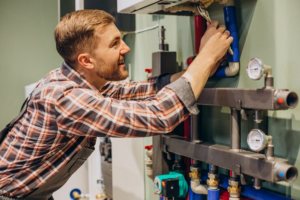
Your home’s furnace is a critical component in keeping your living space comfortable during the cold winter months. To ensure your furnace runs efficiently and reliably, regular maintenance and timely repairs are essential. In this guide, we’ll explore the key aspects of furnace repair and maintenance that every homeowner should be familiar with.
1. Regular Furnace Maintenance
Regular furnace maintenance is the key to extending the lifespan of your heating system and preventing unexpected breakdowns. Here’s what you can do:
A. Change the Filter: One of the most straightforward yet crucial maintenance tasks is replacing or cleaning the air filter. A clogged filter can reduce efficiency and strain the system, leading to increased energy consumption and potential damage.
B. Clean the System: Dust and debris can accumulate in and around the furnace, affecting its performance. Regularly clean the area around the furnace and, if you’re comfortable doing so, clean the furnace’s internal components.
C. Check for Leaks: Inspect the ductwork for any visible leaks, as they can lead to heat loss and reduced efficiency. Sealing any leaks will help your system work more effectively.
D. Schedule Annual Professional Maintenance: It’s highly recommended to have a professional HVAC technician perform an annual maintenance check on your furnace. They can spot and address issues you might miss and ensure the system runs at its best.
2. Common Furnace Issues and Repairs
Understanding common furnace problems can help you address them promptly, potentially preventing more extensive damage. Here are some typical issues and their solutions:
A. Pilot Light Problems: If your furnace has a pilot light, it may go out from time to time. Relight it following the manufacturer’s instructions. If it continues to go out, there may be a faulty thermocouple or gas valve that needs replacement.
B. Strange Noises: Unusual noises like rattling, banging, or screeching can indicate various issues, including loose parts, a worn-out belt, or a malfunctioning blower motor. Promptly addressing these issues can prevent further damage.
C. Inconsistent Heating: If your furnace is struggling to maintain a consistent temperature, it might be due to a faulty thermostat or a clogged air filter. Check these components and replace or repair as necessary.
D. Short Cycling: Short cycling is when the furnace frequently turns on and off. This can be caused by an overheating system, a clogged filter, or a malfunctioning thermostat. Address the root cause to prevent unnecessary wear and tear.
3. Safety Precautions
When performing maintenance or minor repairs on your furnace, safety should be your top priority. Here are some safety precautions to keep in mind:
A. Turn Off the Power: Always turn off the power supply to your furnace before working on it. This includes shutting off the electrical power and the gas supply, if applicable.
B. Proper Ventilation: Ensure proper ventilation when working on your furnace. Carbon monoxide is a byproduct of combustion and can be lethal if not properly vented.
C. Use the Right Tools: Make sure you have the right tools for the job, and if you’re unsure about any aspect of maintenance or repair, it’s best to consult a professional.
Furnace repair and maintenance are essential for keeping your home warm and comfortable. Regular upkeep can extend the life of your furnace and reduce energy costs. By understanding common issues, performing routine maintenance, and taking safety precautions, homeowners can ensure their heating systems operate efficiently and reliably for years to come. If in doubt, it’s always a good idea to consult a professional HVAC technician for expert guidance and assistance.
